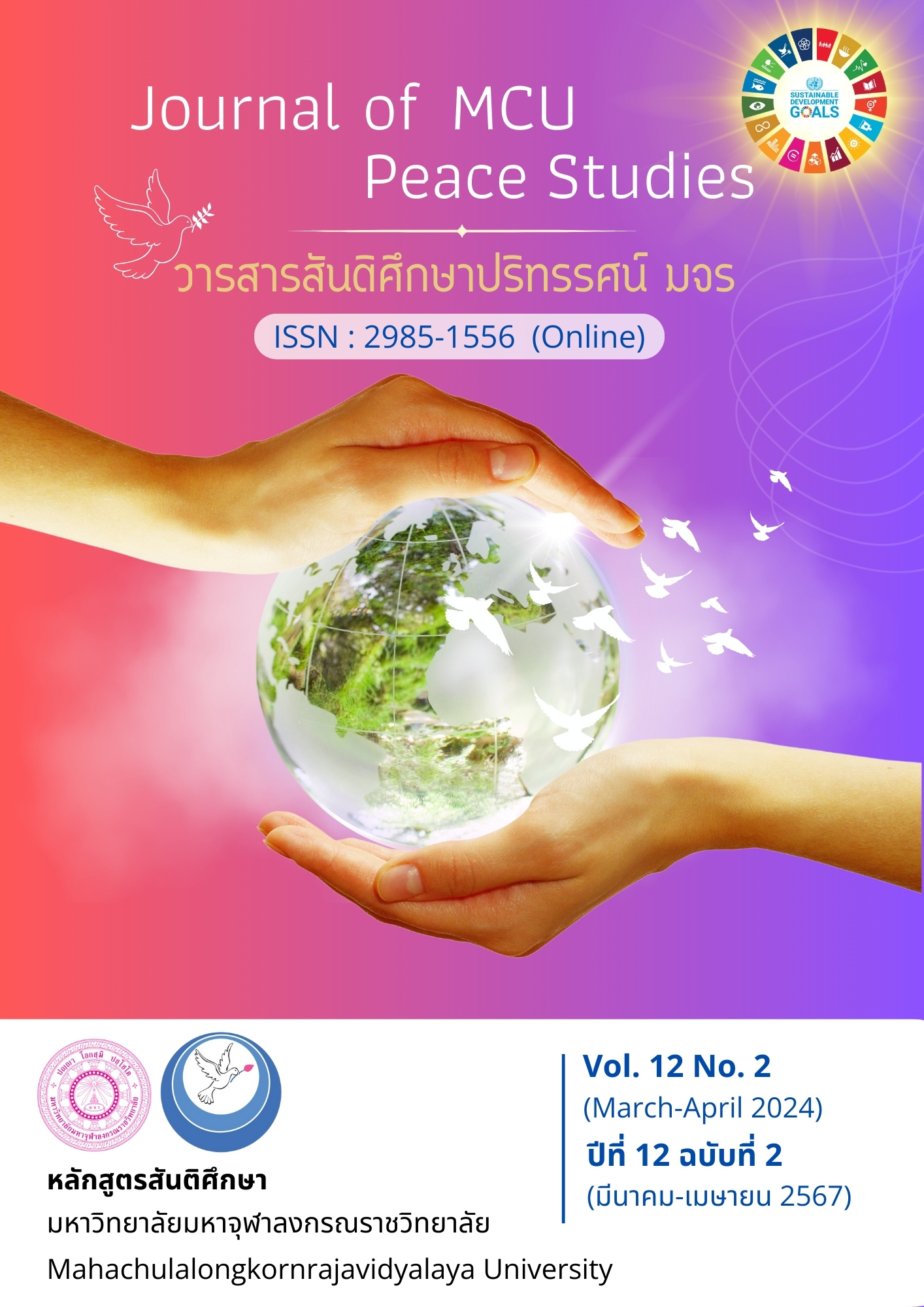The Mediation Process for Building Reconciliation Based on Buddhist Peaceful Means: A Case Study of the Bridge Across to Harrow International School, Don Mueang District, Bangkok
Main Article Content
Abstract
The research article consisted of the following objectives: 1) to analyze problems, context, needs, and concepts relevant to mediation process based on modern science; 2) to examine the Buddhist peaceful means conducive to building reconciliation; and 3) to present mediation process for building reconciliation based on Buddhist peaceful means on a case study of the bridge across to Harrow International School. The study employed an action research based on Ariyasacca (the four noble truths) model under 9-step framework. The in-depth interview was conducted with 25 key informants comprising 25 mediators, scholars, religious officials, and those affected. The focus group discussion was also carried out with 10 persons. The obtained data were analyzed and presented by descriptive method.
From the study, the following results were found: 1) People in the community are experiencing problems as a result of their lack of participation; therefore, a mediation process is required to effect change. Change is caused by volatility, uncertainty, complexity, and ambiguity, all of which contribute to problems in coexistence; 2) Ariyasacca (the four noble truths) is the Buddhadhamma to analyze the parties to the conflict namely, (1) Dukkha, referring to an analysis of conflict, (2) Samudaya, referring to an analysis of the real causes of conflict, (3) Nirodha, referring to the real needs of the conflicting parties, and (4) Magga, referring to dispute mediation process based on the Buddhist peaceful means that focuses on collaboration between conflicting parties to solve problems; and 3) The mediation process for building reconciliation based on the Buddhist peaceful includes the 5 pillars of mediation, which are (1) Pillar of truth, involving speaking the truth even if it is painful, (2) Pillar of love, involving love for one another without complaint or accusing, (3) Pillar of responsibility, involving shared responsibility, (4) Pillar of neutrality and justice, and (5) Pillar of unity, involving the power of people in the community. Dispute mediation process analyzes conflict into the following stages (1) problems, (2) causes of problems, (3) setting goals, and (4) mediation process for building reconciliation under the 9-step framework. This phase involves (1) mindfulness, (2) empathetic companion, (3) deep listening, (4) instance analysis, (5) appropriate thinking, (6) thinking wisely, (7) interest finding, (8) option creating, and (9) new relationship building.
Article Details

This work is licensed under a Creative Commons Attribution-NonCommercial-NoDerivatives 4.0 International License.
Views and opinions expressed in the articles published by The Journal of MCU Peace Studies, are of responsibility by such authors but not the editors and do not necessarily reflect those of the editors.
References
Dispute Settlement Office, Office of the Court of Justice. (2004). Mediation Guidebook. Bangkok: Court of Justice.
Dispute Settlement Office, Office of the Court of Justice. (2004). Dispute Resolution Handbook for the People. Bangkok: Printing House, Jirarat Printing Ltd., Part.
Mahachulalongkornrajavidyalaya University. (1996). Thai Tripitakas. Bangkok: MCU Press.
Mediation Center Department of Good Enforcement. (2015). Regulations of the Legal Execution Department on Mediation of Disputes, 2015. No 1. Manual for the Execution of Mediation. Training Documents for Staff at the Mediation Center between 3-15 December 2015. At A-One the Royal Cruise Hotel Pattaya, Chonburi Province.
Online Manager. (2021). "Srisuwan" Leads the Community along Lat Phrao Canal to sue Bangkok Encourages Village Capitalists to Build a Bridge over a Canal. Retrieved September 1, 2021, from https://mgronline.com/politics/detail/9630000065862
Permpool, S. (2014). The Model of the Buddhist Integrated Mediation: The Alternative Dispute Resolution Office of the Judiciary. (Doctoral Dissertation). Mahachulalongkornrajavidyalaya University. Ayutthaya.
Phra Brahmagunabhorn (P.A. Payutto). (2008). Buddhist Dictionary. Dharma Edition. (16th ed.). Bangkok: S.R. Printing Mass Products Co., Ltd.
Phra Dhampiṭaka (P.A. Payutto). (2003). Crumble Conflict. Bangkok. Saha Thammik.
______. (2010). Buddhist Dictionary. (Compiled Version). Bangkok: Sahathamika Company Limited.
Phra Paisan Wisalo. (2013). Buddhist Mediation in Religious Principles and Dispute Mediation, Version 1.2. Alternative Dispute Resolution Center. Dispute Settlement Office, Office of the Court of Justice. Bangkok: Active Print Co., Ltd.
Phrakrupalad Pannavorawat. (2023). Subject of Research Methods (Handout (PPT). Peace Studies Program. Interview. June 25.
Phramaha Hansa Dhammahãso. (2005). A Pattern of Conflict Management by Buddhist Peaceful Means: A Critical Study of Mae Ta Chang Watershed Chiang Mai. (Doctoral Dissertation). Mahachulalongkornrajavidyalaya University. Ayutthaya.
Phramaha Hansa Dhammahãso. (2013). Religious Principles and Mediation: A Solution to the Sustainably Problem. Bangkok: Thana Place Company Limited.
Trakankunphan, S. (2009). The Process of Mediation in the Justice Process. Course of Senior Justice Administration (Bor Yor Sor). Bangkok: Class 12, College of Justice, Office of the Court of Justice.
Unipan, J., & Sritrapanan, L. (1999). Nursing Education Management and Graduate Quality. The Journal of Boromarajonani College of Nursing, Suphanburi, 1(11), 33-37.


